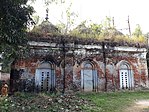
Back منطقة نادية Arabic مديريه ناديه ARZ नादिया जिला Bihari নদিয়া জেলা Bengali/Bangla Districte de Nadia Catalan Nadia (distrito) CEB Nadia (Distrikt) German Distrito de Nadia Spanish Nadia barrutia Basque بخش نادیا Persian
This article needs additional citations for verification. (November 2018) |
Nadia (pronounced [nɔd̪iːaː]) is a district in the state of West Bengal, India. It borders Bangladesh to the east, North 24 Parganas and Hooghly districts to the south, Purba Bardhaman to the west, and Murshidabad to the north.
Nadia district is highly influential in the cultural history of Bengal. The standard version of Bengali, developed in the 19th century, is based on the dialect spoken around Shantipur region of Nadia. Known as the "Oxford of Bengal", Nabadwip made many contributions to Indian philosophy, such as the Navya-Nyaya system of logic, and is the birthplace of the Vaishnava saint Chaitanya Mahaprabhu.[3][4] The district is still largely agricultural.[4]
- ^ a b "Fact and Figures". Wb.gov.in. Retrieved 5 July 2019.
- ^ "52nd Report of the Commissioner for Linguistic Minorities in India" (PDF). Nclm.nic.in. Ministry of Minority Affairs. p. 85. Archived from the original (PDF) on 25 May 2017. Retrieved 5 July 2019.
- ^ Cite error: The named reference
:0was invoked but never defined (see the help page). - ^ a b Cite error: The named reference
Official district websitewas invoked but never defined (see the help page).






